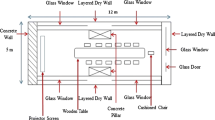Abstract
The present paper deals with device-to-device (D2D) communication for millimeter wave and its performance in indoor wireless communication application. The 61 GHz Industrial Scientific and Medical band is considered for verification of link visibility and path loss behaviour. Line-of-sight (LOS) blockage is the major problem in indoor wireless communication as the signal gets attenuated when the LOS path comes across any obstacle. To overcome this problem, directional antennas are used through which the direction of propagation can be diverted. While selecting such non-line-of-sight (NLOS) path, the transmission path must offer relatively lesser attenuation. The output of this work would be useful for identification of NLOS paths by using beam switching mechanism for D2D communication.





Similar content being viewed by others
References
Tehrani, M. N., Uysal, M., & Yanikomeroglu, H. (2014). Device-to-device communication in 5G cellular networks: Challenges, solutions, and future directions. IEEE Communications Magazine, 52(5), 86–92.
Al-Hourani, A., Chandrasekharan, S., & Kandeepan, S. (2014). Path loss study for millimeter wave device-to-device communications in urban environment. In 2014 IEEE international conference on communications workshops (ICC) (pp. 102–107).
Xue, Q., Fang, X., Xiao, M., & Yan, L. (2016). Multi-user millimeter wave communications with nonorthogonal beams. IEEE Transactions on Vehicular Technology. doi:10.1109/TVT.2016.2617083.
Smulders, P. (2002). Exploiting the 60 GHz band for local wireless multimedia access: Prospects and future directions. IEEE Communications Magazine, 40(1), 140–147.
Attenuation by Atmospheric Gases, ITU Recommendation ITU-R P.676.5.
Winters, J. (1987). System applications for wireless indoor communications. IEEE Communications Magazine, 25(8), 11–20.
Collonge, S., Zaharia, G., & Zein, G. E. (2004). Influence of the human activity on wide-band characteristics of the 60 GHz indoor radio channel. IEEE Transactions on Wireless Communications, 3(6), 2396–2406.
Kutty, S., & Sen, D. (2016). Beamforming for millimeter wave communications: An inclusive survey. IEEE Communications Surveys and Tutorials, 18(2), 949–973.
An, X., Sum, C. S., Prasad, R. V., Wang, J., Lan, Z., Wang, J., et al. (2009). Beam switching support to resolve link-blockage problem in 60 GHz WPANs. In 2009 IEEE 20th international symposium on Personal, indoor and mobile radio communications (pp. 390–394).
Genc, Z., Rizvi, U. H., Onur, E., & Niemegeers, I. (2010). Robust 60 GHz indoor connectivity: Is it possible with reflections? In 2010 IEEE 71st vehicular technology conference (VTC 2010-Spring) (pp. 1–5).
Acknowledgements
The authors deeply express their gratitude to Department of ECE, K L University and to DST through FIST grant SR/FST/ETI-316/2012 for their encouragement during this work.
Author information
Authors and Affiliations
Corresponding author
Rights and permissions
About this article
Cite this article
Cheerla, S., Venkata Ratnam, D., Meghana, S.R. et al. Pathloss Study for 61 GHZ Wave D2D Communications in Indoor Environment. Wireless Pers Commun 97, 387–395 (2017). https://doi.org/10.1007/s11277-017-4510-y
Published:
Issue Date:
DOI: https://doi.org/10.1007/s11277-017-4510-y




